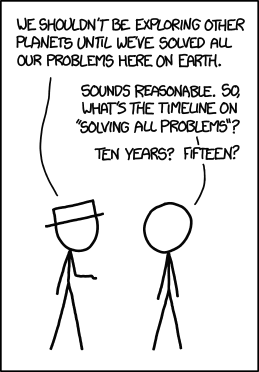Most people know that something called the “equinox” happens twice every year around March 21 and September 21, but don’t really know what that means. Here are the real facts about the equinox.
The sun crosses the celestial equator on September 22 at 4:44 p.m. EDT. On this date the sun rises due east and sets due west, and the day and night are of equal length. Image Credit: Starry Night Software
The Earth moves in two different ways. First, it spins on its polar axis, a line through the north and south poles, once every 24 hours, causing the alternation of day and night. Secondly, it moves in its orbit around the sun once every 365 1/4 days, causing the annual cycle of seasons. The equinox occurs when these two motions intersect.
Because the Earth is very massive, its mass has an enormously powerful gyroscopic effect. For this reason, its poles always point in the same direction, although a major earthquake can cause tiny wobbles in this axis. Most importantly, the Earth’s motion around the sun has absolutely no effect on the direction the poles are pointing, which has very important consequences for Earth’s seasons.
Astronomers mark the positions of objects in the sky relative to the Earth’s poles of rotation: those are the red lines you see in the chart. The most important line is the celestial equator, which divides the sky into northern and southern hemispheres.
The Earth’s pole of rotation is tilted 23.4 degrees relative to the plane of its orbit. This tilt is always towards the same point in the sky, called the celestial pole, no matter where in its orbit around the sun the Earth happens to be. This tilt has the effect on the surface of the Earth that the sun appears to move across the sky at an angle to the celestial equator. This is marked by the green line in the chart, called the “ecliptic” because eclipses happen along this line.
Twice a year, the sun crosses the celestial equator, moving from the northern hemisphere to the southern hemisphere or from the southern hemisphere to the northern hemisphere. These two crossings are very important for the inhabitants of Earth, because they mark the change in the direction the sun’s rays fall on the Earth.
Specifically, on September 22, the sun will move from the northern hemisphere to the southern hemisphere. It will pass overhead everywhere along the Earth’s equator on that date. It will rise exactly in the east and set exactly in the west. After that date, the sun will shine more on the southern half of our planet, and less on the northern half. Summer will be over in the northern hemisphere, and winter will be on its way. Also, winter will be over in the south, and summer will begin.
The sun will continue on its path southward for the next three months, reaching its southernmost point on December 21, the date called “solstice.” In the northern hemisphere, the days will become shorter, the nights longer, and the temperatures colder, all the result of the sun’s being south of the celestial equator.
It’s always important to remember that this is part of a cycle, and that after December 21 the sun will start moving northward again, and spring will be on its way.
